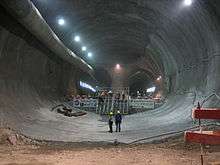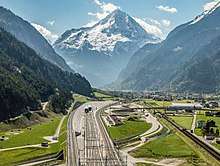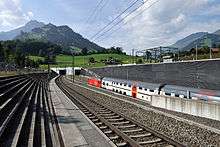NRLA
The New Railway Link through the Alps (NRLA) (German: Neue Eisenbahn-Alpentransversale, NEAT, French: nouvelle ligne ferroviaire à travers les Alpes, NLFA, Italian: Nuova ferrovia transalpina, NFTA), is a Swiss construction project for faster north-south rail links across the Swiss Alps. It includes base tunnels several hundred metres below the existing apex tunnels along two axes, the Gotthard and the Lötschberg. The 57-kilometre (35 mi) Gotthard Base Tunnel and the 35-kilometre (22 mi) Lötschberg Base Tunnel are the respective centers of those two axes.[1] Swiss Federal Railways subsidiary AlpTransit Gotthard AG and BLS AG subsidiary BLS Alp Transit AG (now BLS Netz AG) were founded for this project and built the tunnels.[2]

The total projected cost of the project was CHF 12.189 billion at its 1998 start; in December 2015, its final cost was projected to be CHF 17.900 billion. The 1998 projected total cost of the Gotthard Base Tunnel was CHF 6.323 billion; in December 2015, its final cost was projected to be CHF 9.560 billion.[3] It opened on 1 June 2016, and became operational on 11 December of that year. The 15-kilometre (9.3 mi) Ceneri Base Tunnel is scheduled to become operational in 2020 and will become an important feeder for the Gotthard tunnel.[4] Work on the completion of the second track of the Lötschberg base tunnel is expected to start in 2021/2022 for a targeted opening towards the end of 2028.[5]
Political background

During late 1980s and early 1990s negotiations with the European Economic Community (the predecessor of the EU), Switzerland demanded a limitation on transalpine truck traffic. When the EEC refused, Swiss negotiators instead asked for a heavy-vehicle fee (HVF), a kilometre-based tax on freight vehicles, for all lorries above 3.5 tonnes.[6]
As part of these negotiations, Switzerland offered to build a high-speed rail link through the Alps for intermodal freight transport. Swiss voters approved the link in a 27 September 1992 mandatory referendum.[7] The EU accepted the Swiss offer in 2000, but asked that the 28-tonne weight limit for lorries be raised to 48 tonnes. The parties eventually compromised on a 40-tonne weight limit. The bilateral Land Transport Agreement with the European Union was signed, agreeing to an increase of the kilometer-based tax (HVF; German: LSVA, French: RPLP, Italian: TTPCP) on HGVs from 1.6 ct/tkm to 1.8 ct/tkm when the NRLA was completed. The condition was deemed fulfilled at the completion of the Lötschberg Base Tunnel in 2007.[8]
Other Swiss legislation includes the 1994 Alps initiative, which prohibits road-building in the Alps and encourages the transport of as many transalpine goods as possible by rail rather than road. The 1998 Traffic Transfer Act sets a transfer goal, an ideal maximum number of trucks crossing the Alps by road. Meeting this goals requires a fully functional NRLA rail link.[9]
The original plans for the NRLA included the construction of only one main base tunnel, but regional disputes prevented a choice between the two options and threatened to jeopardize the project. The Swiss Federal Council therefore decided in 1995 to build both base tunnels (Gotthard and Lötschberg) simultaneously.[10]
In 1998, the total projected cost of the NRLA project was CHF 12.189 billion; in December 2015, the final cost was projected to be CHF 17.900 billion. The projected cost of its centerpiece, the Gotthard Base Tunnel, was CHF 6.323 billion in 1998; in December 2015, the tunnel's cost was an estimated CHF 9.560 billion. The 1998 cost of the Lötschberg axis was an estimated CHF 3.214 billion; in December 2015, it was an estimated CHF 4.237 billion.[11][3]
Swiss voters approved the NRLA project on 27 September 1992, with 63.6% support.[7]
On 20 February 1994, the Swiss populace also unexpectedly accepted with 51.9% support the Alps protecting initiative, a federal popular initiative initiated by just a few private citizens. This was despite neither the Federal Council nor the two parliamentary chambers endorsing the initiative, and their not even considering providing a counterproposal to the populace.[9]
Another mandatory referendum was held on 19 November 1998 about the creation of funds for four major public-transport projects (German: FinöV-Fonds, French: Fonds FTP, Italian: Fondo FTP), funding them with time-limited CHF 30 billion fund of which the NRLA would receive 13.6 billion. Another major project was the Bahn 2000 project regarding the modernization of the railways. The Federal Council's request was approved with 63.5% support.[12] The fund is replenished primarily by the previously mentioned kilometre-based tax on heavy-goods vehicles (HVF) and partially by taxes on gasoline originally intended for road-building, a small fraction of the VAT revenues, and funds from the general budget of the Swiss Confederation.
The bilateral agreements with the EU contain the 40-tonne limit and the implementation of the HVF were finally accepted by the Swiss populace on 21 May 2000 with 67.2% support in a federal optional referendum, initiated by opposing political parties.[8]
Gotthard axis

The Gotthard axis consists of the Gotthard Base Tunnel (GBT), the partially operational Zimmerberg Base Tunnel, the Ceneri Base Tunnel (fully bored and being equipped for a 2020 opening), and surface connections. It is being built under contract from the Swiss Federal Government by AlpTransit Gotthard. The axis is the first flat trans-alpine rail link, with a maximum elevation of 550 metres (1,800 ft) above sea level.
This enables a high-speed link through the Alps with a top speed of 250 km/h (160 mph), reducing travel time between Zurich and Milan from previously four hours to currently three-and-a-half hours.[1][13][14][15]
The 57.1-kilometre (35.5 mi) Gotthard Base Tunnel is the world's longest and deepest traffic tunnel,[16][17][18] as the original 15-kilometre (9.3 mi) Gotthard Tunnel was at its completion in 1881. It consists of two single-track tunnels, connected by 178 cross-connections. There are two emergency stations in each tunnel, each connected to the corresponding opposite-tunnel emergency station. These stations are equipped with water supplies to refill firefighter and rescue trains. One (Porta Alpina) was proposed as a 800m deep rail station, but the proposal was rejected on both economic and technical grounds. The completed tunnel was handed over to the Swiss government by AlpTransit Gotthard on 31 May 2016. It was formally opened in a ceremony the next day, during which the tunnel was conveyed to its operator: Swiss Federal Railways (SBB CFF FFS).[19][20]
Lötschberg axis

The Lötschberg axis, with the Lötschberg Base Tunnel (LBT) in the Bernese Alps, was built by BLS Alp Transit. The 34.6-kilometre-long (21.5 mi) base tunnel opened to traffic on 7 December 2007; it was the first part of the NRLA to be delivered, but is only partially completed. It supports the western transit network via Basel, Olten, Bern, Brig, Domodossola and Milan. The tunnel replaces the existing higher-altitude 1913 14.6-kilometre (9.1 mi) Lötschberg Tunnel for most traffic. Because of NRLA cost overruns, funding for the axis was however diverted to the Gotthard Base Tunnel and only one of the tunnel's two bores has been completed and is fully equipped for rail use. 14 kilometers of the other bore are completed; 14 kilometers are excavated but not equipped, and 7 kilometers have not been excavated. High-speed switches allow the completed third to be used as a passing track,[1][21][22] but the 21 kilometres (13 mi) of single track without passing loops complicates operations and greatly reduces the line capacity. Trains are scheduled by batches in each direction and separated by long intervals; trains more than seven minutes late are routed via the old line or must wait for the next available timetable slot in their direction in the tunnel, causing major further delays. A planning contract was awarded in 2016 for the completion of the second track of the LBT, which is estimated to cost 1 billion Swiss francs.[23] The resulting plan was presented in Spring 2019, and construction is expected to start in 2021/2022 and to be completed by the end of 2028.[5]
The second part of the Lötschberg axis is the Simplon Tunnel, completed in 1905 as a 20-kilometre-long (12 mi) single-track base tunnel and augmented with a second bore in 1921. It connects Upper Valais to Northern Italy's Piedmont region.
References
- "Overview". AlpTransit Portal. Berne, Switzerland: Federal Swiss Archives FSA, Federal Office of Transport FOT. Retrieved 1 July 2017.
- "Construction". AlpTransit Portal. Berne, Switzerland: Federal Swiss Archives FSA, Federal Office of Transport FOT. Retrieved 1 July 2017.
- National Councillor Thomas Müller, Councillor of State Isidor Baumann (29 April 2016). "Oberaufsicht über den Bau der Neat im Jahre 2015: Bericht der Neat-Aufsichtsdelegation der eidgenössischen Räte zuhanden der Finanzkommissionen, der Geschäftsprüfungskommissionen und der Kommissionen für Verkehr und Fernmeldewesen" (PDF). Bundesblatt (in German, French, and Italian). 2016 (16.005). NRLA supervisory board of the federal councils: 6686. BBl 2016 6665 (-6732). Retrieved 6 June 2017. Cite journal requires
|journal=(help)CS1 maint: uses authors parameter (link) - "The Gotthard Base Tunnel". Luzern, Switzerland: AlpTransit Gotthard AG. Retrieved 15 October 2016.
- "Lötschberg plans full rail baseline finish". www.tunneltalk.com.
- "Agreement with Europe". AlpTransit Portal. Berne, Switzerland: Federal Swiss Archives FSA, Federal Office of Transport FOT. 2 May 1992. Retrieved 1 July 2017.
- "Yes to the NRLA". AlpTransit Portal. Berne, Switzerland: Federal Swiss Archives FSA, Federal Office of Transport FOT. 27 September 1992. Retrieved 1 July 2017.
- "The end of the 28-tonne limit". AlpTransit Portal. Berne, Switzerland: Federal Swiss Archives FSA, Federal Office of Transport FOT. 21 May 2000. Retrieved 1 July 2017.
- "Yes to the Alps Initiative". AlpTransit Portal. Berne, Switzerland: Federal Swiss Archives FSA, Federal Office of Transport FOT. 24 February 1994. Retrieved 1 July 2017.
- "Green light for the network option". AlpTransit Portal. Berne, Switzerland: Federal Swiss Archives FSA, Federal Office of Transport FOT. 20 February 1995. Retrieved 1 July 2017.
- "Transport policy as financial policy". AlpTransit Portal. Berne, Switzerland: Federal Swiss Archives FSA, Federal Office of Transport FOT. 29 May 1995. Retrieved 1 July 2017.
- "Yes to public transport funding". AlpTransit Portal. Berne, Switzerland: Federal Swiss Archives FSA, Federal Office of Transport FOT. 29 November 1998. Retrieved 1 July 2017.
- "Results for Gotthard". AlpTransit Portal. Berne, Switzerland: Federal Swiss Archives FSA, Federal Office of Transport FOT. Retrieved 1 July 2017.
- "Gotthard Base Tunnel: Tunnel technology for the future" (PDF). Heerbrugg, Switzerland: Leica Geosystems. Retrieved 1 July 2017.
- Shafy, Samiha (31 December 2006). "Elevator to the Underworld". Der Spiegel. Hamburg, Germany. Retrieved 1 July 2017.
- "Gotthard- und CeneriBasistunnel: die neue Gotthard-Bahn nimmt Gestalt an" (PDF). Geomatik Schweiz. Archived from the original (PDF) on 4 March 2016. Retrieved 8 June 2015.
- "Wer hat die grösste Röhre?" [Who has the longest tube?]. Tages-Anzeiger (graphical animation) (in German). Zurich, Switzerland. 14 April 2016. Retrieved 11 May 2016.
- "Gotthard tunnel: World's longest and deepest rail tunnel opens in Switzerland". BBC News. 1 June 2016. Retrieved 1 June 2016.
- "High-profile guests at the opening ceremony". AlpTransit Portal. Berne, Switzerland: Federal Swiss Archives FSA, Federal Office of Transport FOT. 1 June 2016. Retrieved 1 July 2017.
- "Festival marks Gotthard Base Tunnel opening". Railway Gazette. DVV Media UK Ltd. 1 June 2016. Archived from the original on 1 June 2016. Retrieved 1 June 2016.
- "Results for Lötschberg". AlpTransit Portal. Berne, Switzerland: Federal Swiss Archives FSA, Federal Office of Transport FOT. Retrieved 1 July 2017.
- "The Lötschberg enters operation". AlpTransit Portal. Berne, Switzerland: Federal Swiss Archives FSA, Federal Office of Transport FOT. 9 December 2007. Retrieved 1 July 2017.
- "Planning contract awarded for Lötschberg Base Tunnel track doubling". 1 February 2016.
External links
| Wikimedia Commons has media related to Alptransit. |
- AlpTransit.ch
- AlpTransit Portal of the Swiss Federal Archives
- The New Rail Link through the Alps (NRLA) by the Federal Office of Transport FOT
- A construction project serving Europe – The opening of the Gotthard Base Tunnel in 2016 by Presence Switzerland, FDFA
- Alpine Initiative site with political background information